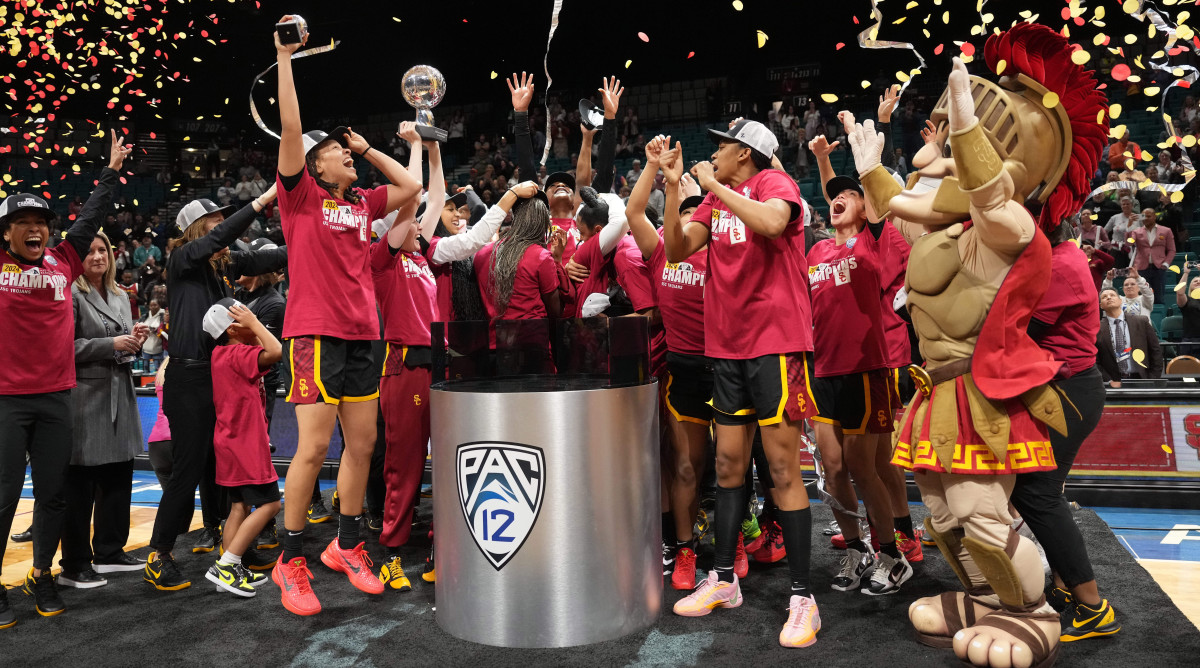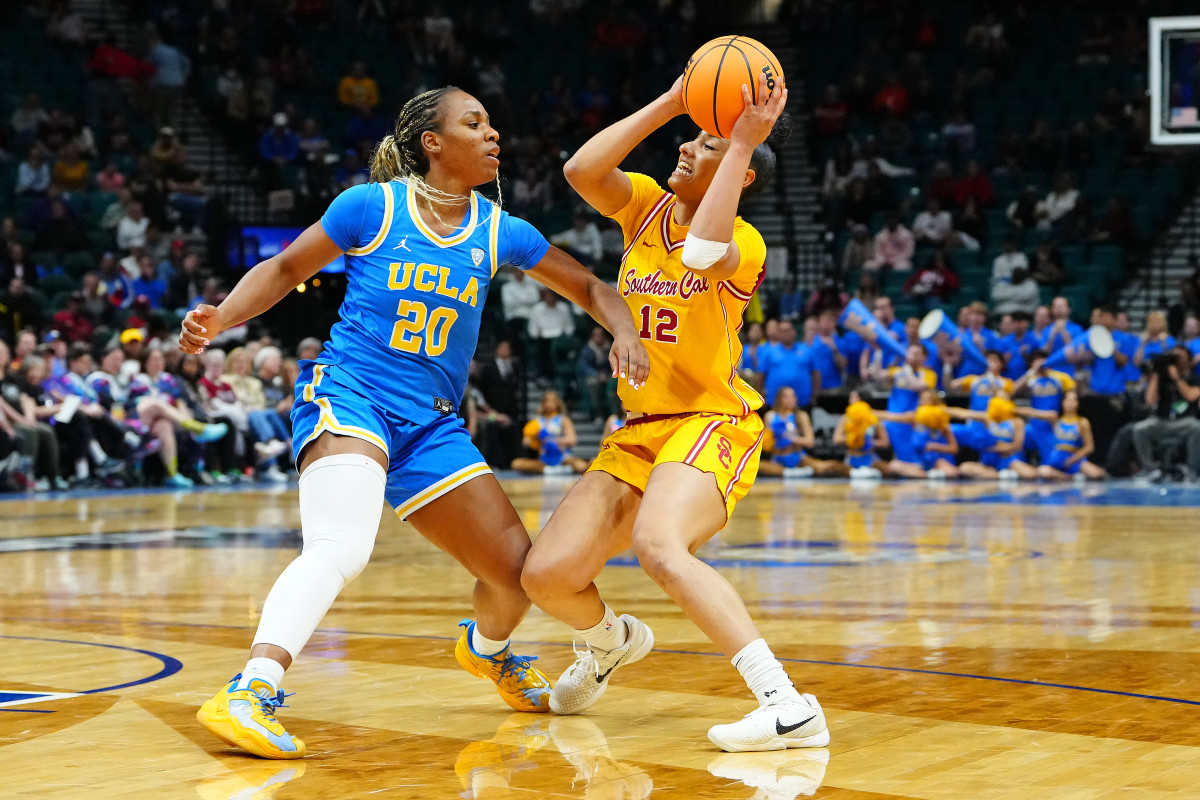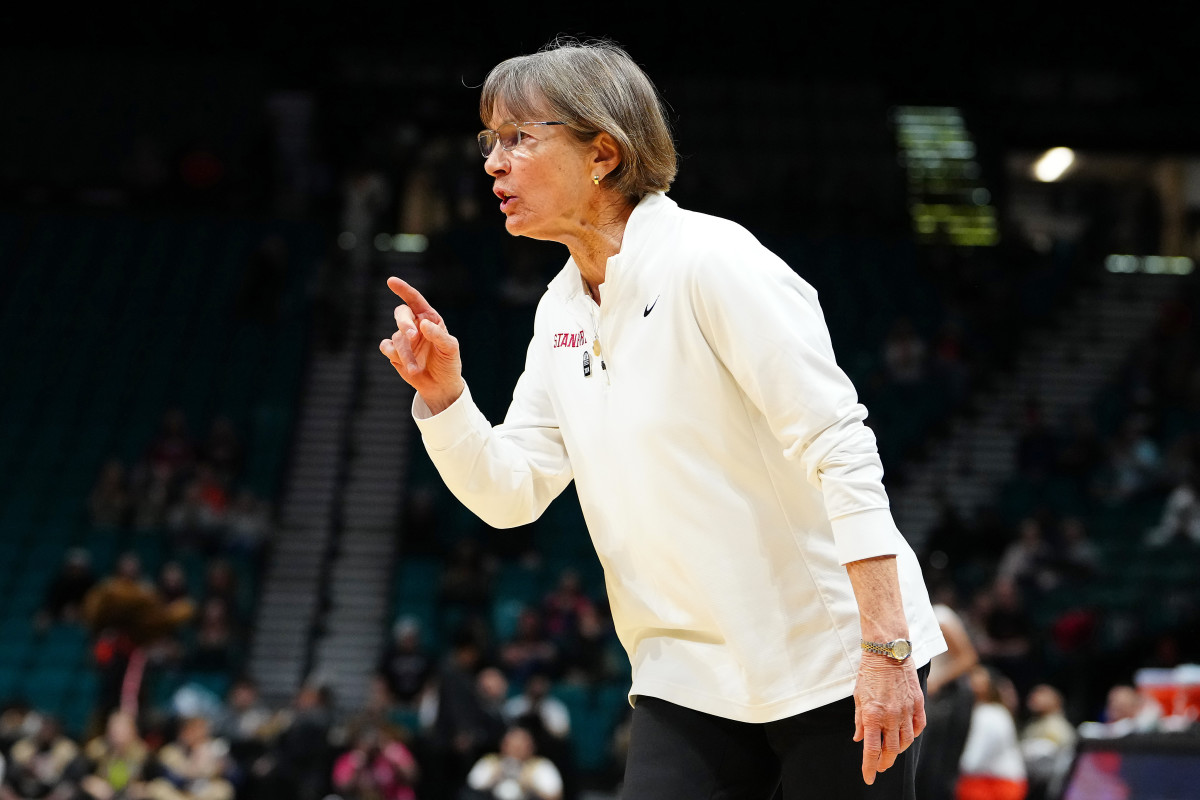A Fitting Farewell to Pac-12 Women’s Basketball
LAS VEGAS — The merchandise stand is stocked with jewel tones. The Pac-12 women’s basketball tournament offers Washington purple, Oregon emerald, Southern California gold. But the most popular shirt here is plain white.
It’s the conference merch that everyone wants: A simple white tee with the Pac-12 logo on the chest. (On the first day of the tournament, it sold out in every size by mid-afternoon, before the second half of the daily slate could even tip off; more were ordered for the coming days.) The fans have come to cheer on their respective teams, of course, but they have also come to say goodbye. If the tournament is primarily a display of some of the best teams in the country, it also feels like part farewell party, part wake.

This year marks the functional end of the Pac-12. Come the summer, 10 of the 12 member schools will scatter to other conferences, torn apart in a college sports environment controlled by television and football. (The conference will continue on in name, if not exactly in spirit, with its two remaining programs, the Oregon State Beavers and Washington State Cougars.) The loss of tradition and regional rivalry will be felt in every sport. But there’s a particular sting for women’s basketball. The conference has long set the standard for investment in the game and regularly competitive play. It’s been the home of Tara VanDerveer, the winningest coach in the sport and the architect of three national titles with the Stanford Cardinal; of Lisa Leslie and Tina Thompson and other luminaries for the USC Trojans; of former NCAA women’s leading scorer Kelsey Plum for the Washington Huskies and triple-double queen Sabrina Ionescu for the Oregon Ducks. That legacy holds right up to the present moment, with some of the strongest teams in the sport and some of the fiercest, most engaging rivalries. Other conferences have more national championships. None have been able to claim such a varied swath of broadly competitive programs and stars for so long as the Pac-12.
It played its final games at last week’s tournament in Vegas.
“It's just the most unfortunate thing I can think of that this is kind of the end of the Pac-12,” said Washington State coach Kamie Ethridge. “It's the highlight of women's basketball across the country. And it's insane that we're not going to be continuing this or have a West Coast footprint.”
Hence all the fans rushing to buy those conference T-shirts. Such as Brenda Kuleck, a Stanford fan without any connections to the school except for her deep, long-standing admiration of VanDerveer, who has been with the program since 1985. Kuleck lives just outside of Philadelphia and had never been to a Stanford game before last week. But she knew she had to make it to one this year. To follow Stanford all these decades had been to follow the Pac-12, and if she was finally going to see VanDerveer, she wanted it to be within the conference. She decided to swing big and go for the five-day tournament. When her husband wasn’t interested, she recruited her sister to join her instead, and the two of them got in line for conference T-shirts on the morning of the first day. Kuleck put hers on immediately. Asked how it felt, she was briefly overcome by emotion.
Her sister helped with an answer.
“Just getting to the entrance this morning, tears were coming into her eyes, because it’s been a thrill of hers, a dream of hers to be able to be here,” said her sister Harriet Deiter. “And now she’s just having a ball, and I’m having a ball, too.”
It was an incredible time, they said. It was also more than a bit depressing.
“The sentiment is the same from everybody,” Kuleck said. “Everybody’s sad.”

The feeling extended to players and coaches. But that shared sadness carried with it a sense of camaraderie. Coaches talked about how they had felt supported by one another over the years. They spoke about the strength of the conference, advocating for tournament berths and high seeds, even for their opponents. (That was due, in part, to a feeling of being nationally overlooked as a collective: “They're not watching us at midnight. They're not writing about us. They're not talking about us and don't give us enough credit. That's the unfortunate thing about the Pac-12. It's never gotten the love and flowers it deserves,” said Arizona Wildcats coach Adia Barnes. “That's been the story because of our TV deals.”) If they didn’t speak up for each other, it seemed, they weren’t sure who else would. Soon, there would be no one left to do it at all.
The quality of the basketball generally managed to live up to the moment. The quarterfinals included the first double-overtime game in conference tournament history. (Oregon State outlasted Colorado.) The semifinals then brought another the very next day. (USC beat UCLA in a thriller after the rivals split their season series.) It was a snapshot of a few evenly matched teams playing in the most exciting part of the calendar. But it was also a testament to the environment the conference has cultivated for women’s basketball over decades.
“The conference has just been an unbelievable platform for female athletes,” said USC coach Lindsay Gottlieb. “Really special conference in terms of the values and what these schools represent. And there's obviously just some sadness in terms of this being the last one.”
That spirit meant that players over the years found themselves drawn to the conference as much as they were drawn to their individual programs or coaches.
“I'm a West Coast kid, so I grew up with the Pac-12 being big-time sports,” said Utah Utes coach Lynne Roberts, who is from Redding, Calif. “You can recruit because the league is so appealing … Kids wanted to play in it.”
It only made sense that idea held for many players on the West Coast. But it was true for many others, too, including those much further afield.
“I really wanted to play in the Pac-12 when I got recruited. That was a big thing for me,” said Colorado guard Frida Formann, who did not come to college with any personal ties to the West Coast. The senior is from Bagsværd, Denmark. But while in high school at Falkonergårdens Gymnasium—not exactly a feeder institution for the Pac-12—she found herself watching as much as possible of Ionescu and her teammates at Oregon. “I was like, Oh, my God, I really want to play in a conference like that, where they play like that.”
The sense of loss is acute even for the two schools remaining in the conference. When Oregon State had its first shootaround in Vegas, two nights before the start of the tournament, Beavers coach Scott Rueck found himself idly dribbling at center court as he watched his players get their shots up. Then he looked down at the conference logo beneath his feet.

“Knowing that it's the end, it's still a bit surreal because it's all I've known my whole life, being a native Oregonian and a fan of Oregon State for every year I've been alive, to realize, Wow, this is it,” said Rueck, who has led the Beavers since 2010. “It still kind of doesn't seem real. Then it turns into gratitude, and I'm happy to be a part of it, and what an honor it's been all these years.”
The tournament championship game featured two schools that will no longer share a conference after this year. Stanford will be in the ACC, and USC the Big Ten. (The Trojans won 74–61 on the strength of 26 points from transfer guard McKenzie Forbes.) Both will likely be No. 1 seeds this year in the NCAA tournament, each carrying on program traditions, Stanford as a steadily dominant powerhouse over years and USC as a recent revival project. But they will not play again in the Pac-12.
“I’m sorry this is the last conference game and the last time that we’ll be playing them,” VanDerveer said. “But it’s been a great ride.”
